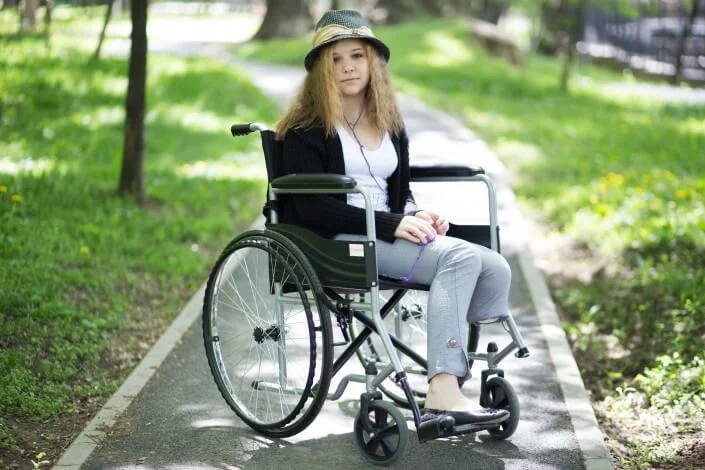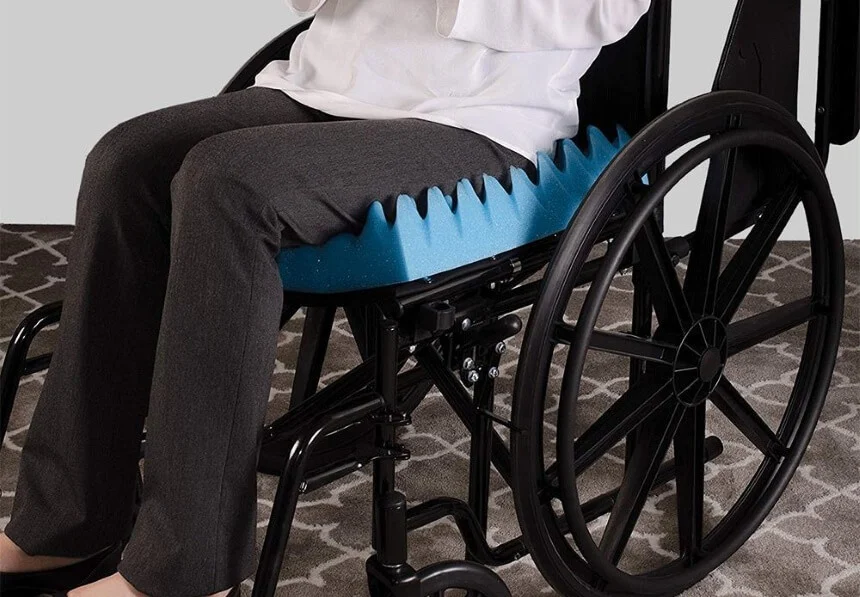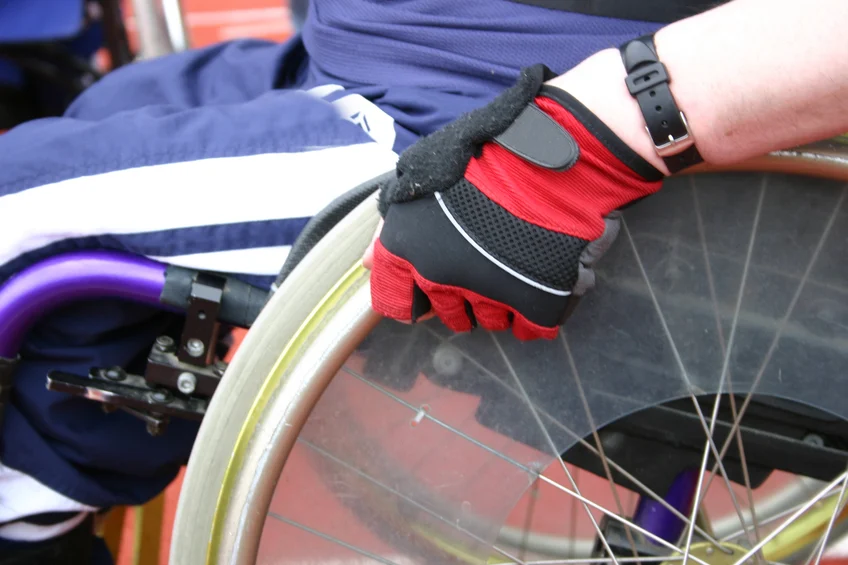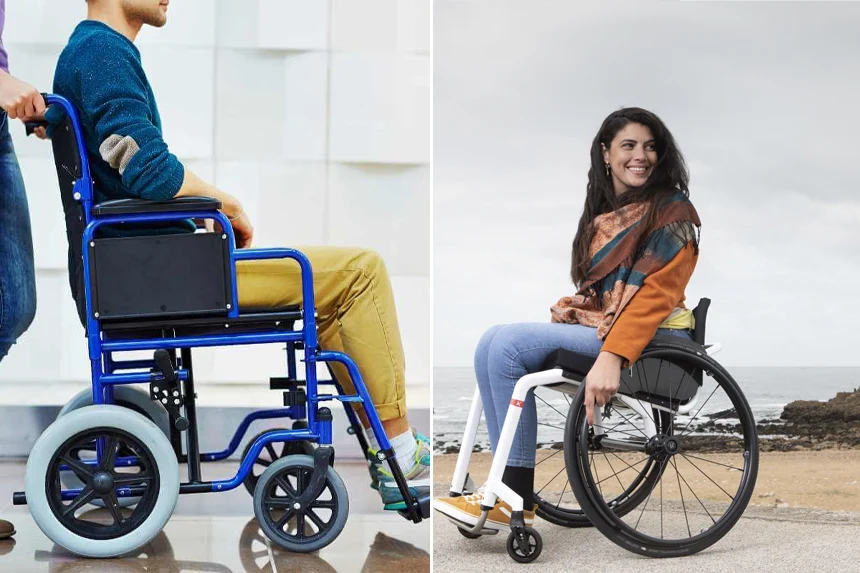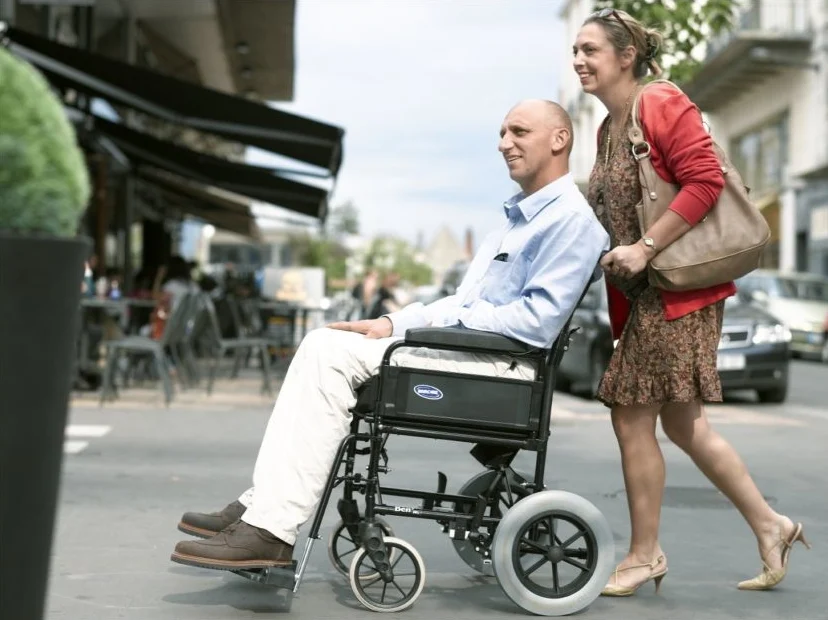Wheelchairs dramatically improve quality of life for those with mobility challenges – but unfortunately, they often come with a hefty price tag. A new wheelchair can cost anywhere from a few hundred to several thousand dollars, putting it out of reach for many seniors and people with disabilities on fixed incomes. The good news? You may not have to pay for a wheelchair at all. In the United States, there are multiple ways to get a wheelchair for free or at a very low cost. These include government assistance (like Medicare or Medicaid), special programs for veterans, a wide array of non-profit organizations and charities, community resources, and even websites where generous individuals donate used wheelchairs to those who need them.
In this updated guide, we’ll walk you through the most useful services and up-to-date strategies (as of 2025) for obtaining a free wheelchair. Whether you’re a senior, a person with a disability, a veteran, or a caregiver, this article will help you navigate the options and find the solution that fits your situation. No one should go without mobility simply because of cost, so let’s explore how you can get the wheelchair you need at no charge and regain your freedom of movement.
By Nan J.Corbo | ✅ Reviewed by Ray Butcher |
SeniorFitness is reader-supported. We may earn a commission through products purchased using links on this page. Learn more about our process here
TL;DR: How to Get a Wheelchair for Free
You can get a wheelchair for free by tapping into various programs and organizations. Options range from Medicare/Medicaid coverage and VA benefits for veterans, to numerous charities, community lending closets, and online exchanges where people donate wheelchairs. Even second-hand options like thrift stores or matching programs can connect you with a free wheelchair. It takes some research and documentation (like a doctor’s note), but many people qualify for at least one of these avenues. Keep reading to learn all the proven ways – including one often-overlooked resource that might surprise you – to secure a wheelchair without out-of-pocket costs. (Hint: Don’t miss the tip about an online platform where strangers help each other out!)
What Types of Wheelchairs are Given for Free?
Wheelchairs come in many types to suit different needs, and you might be wondering which kinds are available through free programs or donations. The good news is that virtually every type of wheelchair – from basic manual chairs to high-end electric models – can potentially be obtained for free, provided you meet the criteria of the assisting program. Here’s a quick overview of wheelchair types and how they factor into getting one at no cost (for a deeper dive into wheelchair varieties, see our guide on the types of wheelchairs):
Transport
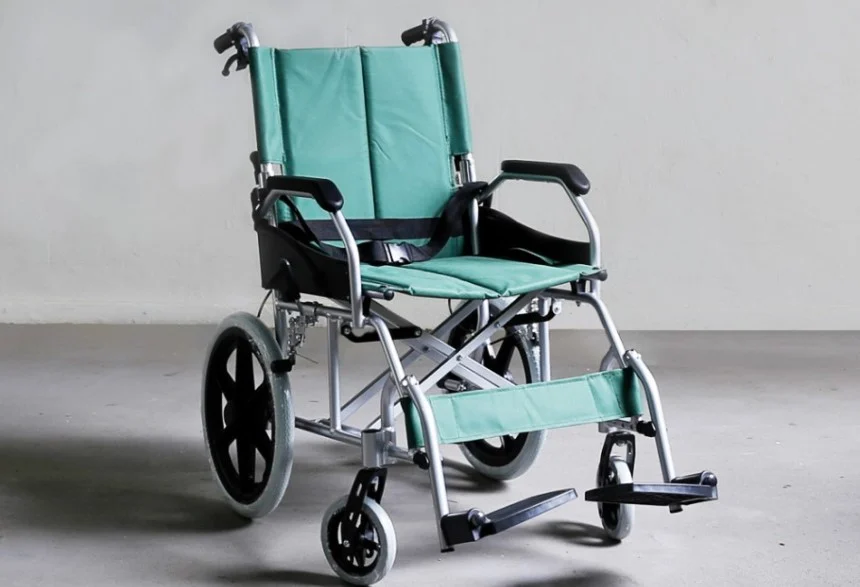
These lightweight chairs are designed to be pushed by a caregiver (they have small rear wheels that the user cannot self-propel). Transport chairs are commonly donated or provided by charities, especially if you have someone (like a family member or aide) to assist you. For example, a basic transport chair such as the Drive Medical Lightweight Steel Transport Wheelchair could be available through a hospital lending program. If you’re seeking a free transport wheelchair, be prepared to show that you have a helper who can push you – some government programs (like Medicare) will require evidence that you cannot use a self-propelled chair on your own. Community health organizations often keep a few transport chairs on hand for short-term loans too.
Manual

Manual wheelchairs are the classic, standard wheelchairs that you propel with your arms (or someone can push from behind). They range from very basic models to more lightweight or specialized ones. These are the most commonly available free wheelchairs because they are simpler and cheaper than electric models. In fact, many charities and insurance programs prioritize manual wheelchairs as a first option. Manual mobile aids make the best lightweight wheelchairs that are robust and weigh somehwere between 15 to 60 pounds.
Some of the best lightweight wheelchairs are on the lower end of that range, making them easier to lift and transport. If you’re worried about handling a chair, remember that there are ultra-light models out there – and if you’re curious about weight specifics, our article on how much wheelchairs weigh breaks it down. The bottom line: if you need a robust, everyday wheelchair, a manual model will likely be the easiest to get for free through programs for seniors and those with a dissability.
Motorized
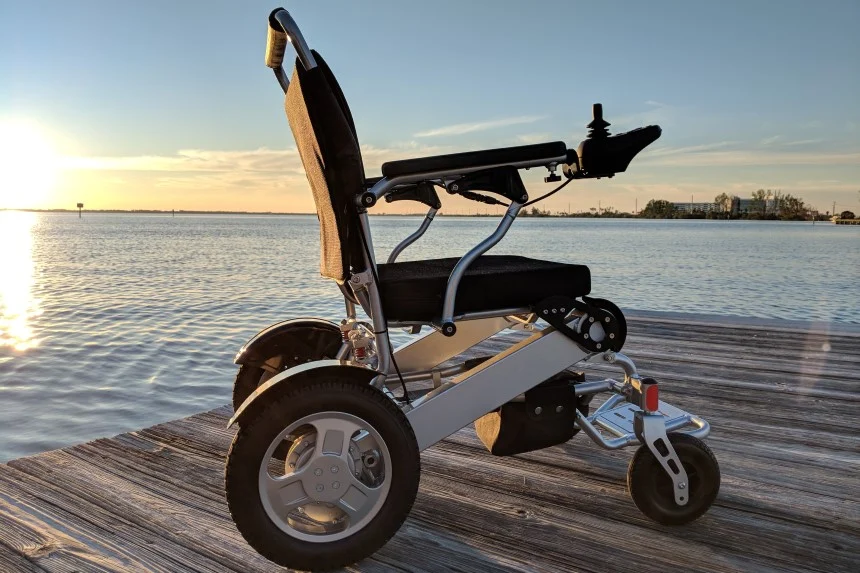
Motorized wheelchairs (also called electric wheelchairs or power chairs) have a battery and motor, so you can drive them with a joystick or controls. These can be life-changing if you lack the strength to use a manual chair. It is possible to get a free motorized wheelchair like the Porto Mobility Ranger D09, but the requirements are stricter due to the higher cost. Typically, you’ll need a doctor’s note explicitly stating why a motorized chair is a medical necessity for you (for example, perhaps you have severe arthritis, neuromuscular problems, or amputations that prevent you from using a manual wheelchair effectively).
Programs like Medicare will cover a power wheelchair only if a manual wheelchair or scooter won’t meet your needs and if you can safely operate the device (or have a caregiver who can help). Don’t be discouraged – many people do successfully obtain powered chairs through insurance or charities with the right documentation. The best one we have experience with is the 50-pound Porto Mobility Ranger D09 power wheelchair, which has a high weight capacity of 400 lbs; a patient who genuinely needs such a device for daily activities can get it covered by Medicare with a detailed doctor’s prescription. We’ll discuss Medicare’s role soon – just keep in mind that free motorized wheelchairs are available, but you’ll have to justify the medical need.
Electric
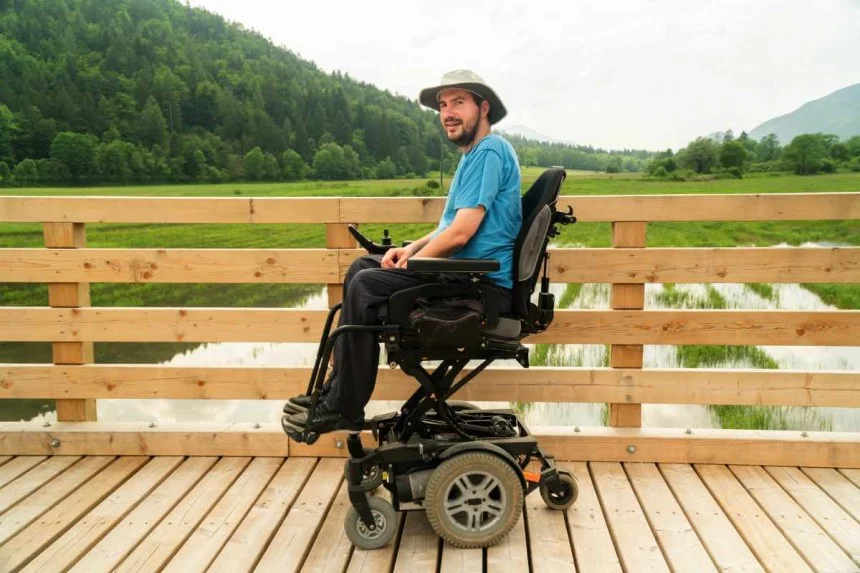
While technically not “wheelchairs,” mobility scooters are another mobility aid often sought by seniors. Scooters (the kind you sit on, with a tiller for steering) might be easier to get from some charities or through Medicare Part B (which covers “Power-Operated Vehicles” like scooters) if you don’t quite need a full wheelchair. If you think a scooter suits you better than a wheelchair, similar free options exist. In fact, Medicare uses similar criteria for scooters as it does for power wheelchairs Some readers might be interested in our separate guide on how to get a free mobility scooter for more details – but rest assured, many of the resources we’re about to cover (Medicare, Medicaid, charities, etc.) can help with scooters as well.
Specialized & Custom Wheelchairs
If you need a very specific type of wheelchair (e.g., a pediatric wheelchair for a child, a sports wheelchair, or a power wheelchair with custom seating), free options still exist but might take a bit more effort. Organizations like the Muscular Dystrophy Association (MDA) or Cerebral Palsy sometimes assist members with obtaining specialized mobility devices. Additionally, some manufacturers have assistance programs for complex rehab chairs. Veterans often can get custom chairs (even high-tech ones) through the VA. We’ll touch on these scenarios throughout the article. Just know that “free wheelchair” doesn’t only mean basic models – with advocacy and the right contacts, even high-end wheelchairs can be procured at no cost to you if medically needed.
Government Programs That Help You Get a Free Wheelchair
When seeking a free wheelchair, government assistance programs are often the first (and best) place to start if you’re eligible. The two major programs are Medicare (federal health insurance for seniors 65+ and certain disabled individuals) and Medicaid (state-run insurance for low-income and disabled people). There are also specialized options for veterans through the Department of Veterans Affairs. Here’s how each can help:
Medicare or Medicaid

If you’re a senior or otherwise enrolled in Medicare, you have a very good chance of getting help with a wheelchair. Medicare Part B covers Durable Medical Equipment (DME), which includes wheelchairs and power mobility devices, as long as certain conditions are met. While Medicare typically doesn’t just “give out” free wheelchairs without any cost, it can make a wheelchair mostly free by covering the majority of the expense – and if you have supplemental insurance or Medicaid as a secondary, your out-of-pocket cost could be $0. Here’s how it works:
- Medical Necessity: Medicare will cover a wheelchair if your doctor certifies that you have a medical condition that significantly impairs your mobility within your home. The key phrase often used is that you need a wheelchair to perform activities of daily living (like bathing, dressing, moving around your house) and that without it, you’re essentially homebound. If you can get by with a cane or walker, Medicare likely won’t approve a wheelchair – the need has to be greater than what simpler aids can accommodate.
- Face-to-Face Exam & Prescription: You must have a face-to-face examination with a Medicare-enrolled doctor who evaluates your mobility limitations. If they determine a wheelchair is necessary, they will write a prescription/order for the specific type of wheelchair (manual vs power) you needgoodrx.com. Timing is important: the exam for a manual chair must be within 6 months of the prescription, and for a power wheelchair, within 45 daysgoodrx.com. This ensures your need is current.
- Supplier and Paperwork: The wheelchair must be obtained through a Medicare-approved DME supplier (vendor). Both your doctor and the supplier must be enrolled in Medicare and follow Medicare’s procedures. Often the supplier will handle submitting a prior authorization request to Medicare if it’s a power wheelchair (power devices usually need approval from Medicare before delivery). For manual wheelchairs, prior authorization isn’t universally required, but the documentation still needs to be in order.
Medicare Costs Consideration for Wheelchairs
- Costs Covered: Medicare Part B typically covers 80% of the cost of the wheelchair, after you meet your annual Part B deductiblegoodrx.com. For example, in 2025 the Part B deductible is $226. Once that’s paid (if not already met through other medical services), Medicare pays 80% and you pay 20% of the Medicare-approved amount. However, many people have secondary insurance – either a Medigap plan or Medicaid – that can cover that remaining 20%. If you have such coverage, you could end up paying nothing at all. Even without secondary insurance, 80% coverage is a huge help; some suppliers may also waive or reduce the remainder for hardship cases or help find charitable assistance for it. It’s worth noting that Medicare’s coverage is usually for a basic model wheelchair sufficient for your needs. If you want deluxe features not deemed medically necessary, you might have to pay extra for those.
- Rent vs. Buy: Medicare often rents the wheelchair on your behalf rather than buying it outright immediately. Typically, if you need the wheelchair long-term, Medicare will pay a monthly rental fee to the supplier for 13 months, after which you own the wheelchairgoodrx.com. During the rental period, you’re responsible for the 20% coinsurance each month (if you have no secondary insurance). After 13 months of continuous use, the supplier transfers ownership to you, and Medicare stops paying. (In some cases, for cheaper manual chairs, Medicare might purchase it outright instead; policy can vary depending on the equipment.) This rental structure is mostly behind the scenes – the supplier handles it – but it’s good to know you may not get a brand new chair in a box; you’ll get a chair from a supplier who is effectively leasing it via Medicare initially.
Medicare is a fantastic route to get a wheelchair at minimal cost if you’re enrolled and have a documented need. Start by talking to your doctor, bring up that you’re struggling with mobility and ask if a wheelchair might help. They can then guide you through the necessary steps.
Also remember: if you’re in a Medicare Advantage plan (an HMO or PPO), the plan is required to cover at least what Medicare covers, but you’ll need to follow your plan’s rules (which might mean using certain suppliers or getting prior authorization through the insurance company). Check your plan’s benefits; many Medicare Advantage plans have $0 copays for durable medical equipment, meaning they could cover the wheelchair fully. Always inquire!
Medicaid To Get a Wheelchair for Free
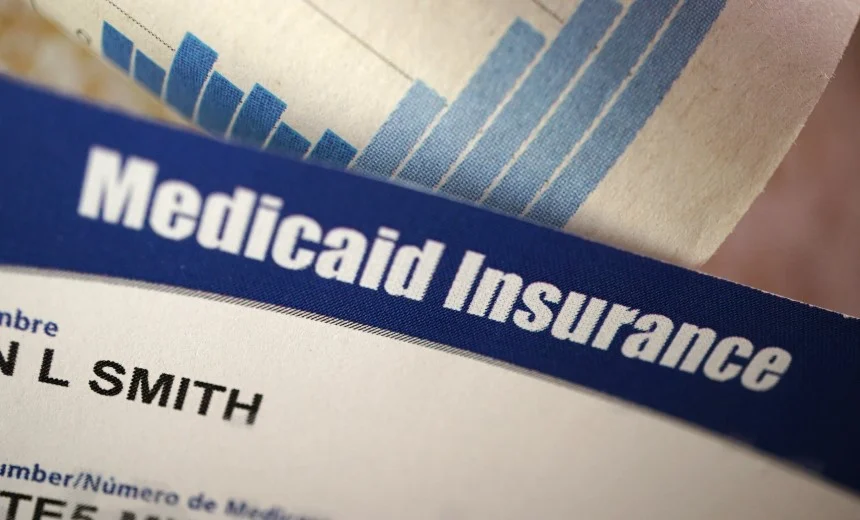
Medicaid is another major payer for wheelchairs and can be a game-changer, especially if you have limited income. While Medicaid is not a single national program (each state runs its own Medicaid with slightly different rules), all states’ Medicaid programs cover wheelchairs as medically necessary equipment for those who qualify. In fact, if you have both Medicare and Medicaid (dually eligible), Medicaid will typically pay the 20% that Medicare doesn’t cover, meaning you get the wheelchair free.
Eligibility for Medicaid: First, you need to qualify for Medicaid itself. Eligibility varies by state, but generally it’s based on low income and limited assets. Many seniors qualify if they have very low income, or if they have high medical expenses (there are “Medically Needy” pathways). People with disabilities under 65 can also qualify via SSI (Supplemental Security Income) or other disability-related categories. Some states expanded Medicaid to cover more low-income adults. Check with your state’s Medicaid office or Health and Human Services department for specifics on income thresholds.
Medicaid Coverage for Wheelchairs: Medicaid typically covers 100% of the cost of a wheelchair for beneficiaries, as long as it’s medically necessary. There usually is no copay or cost-sharing for durable medical equipment in Medicaid (or if there is, it’s minimal, like $1 or $3 in some states). Medicaid uses a similar process: you need a doctor’s prescription and often prior authorization from Medicaid before getting the equipment. The criteria for “medically necessary” are often the same as Medicare’s (in fact, some states directly reference Medicare’s guidelines). If you can’t perform daily activities without a wheelchair, and other aids won’t suffice, you’re likely to be approved.
Medicare vs. Medicaid Process: If you have both Medicare and Medicaid, you actually have a great setup: Medicare will be billed first, pay its 80%, then Medicaid covers the rest. From your perspective, it should be seamless – just make sure the supplier knows you’re dual-eligible so they can coordinate billing. If you only have Medicaid, the process is solely through Medicaid’s approved providers. Some smaller medical suppliers might not take Medicaid if reimbursement is low, so you may need to find one that is a Medicaid provider. Your Medicaid caseworker or the state’s Medicaid website usually lists DME providers.
Getting a Free Wheelchair through Medicaid
How to Apply/Use: To use Medicaid for a wheelchair, you will follow a process similar to Medicare’s: doctor’s prescription -> find a Medicaid-approved supplier -> supplier submits a request to Medicaid -> get approval -> receive wheelchair. Your doctor or hospital discharge planner might help start this process. You can also call the member services number on your Medicaid card for guidance. Keep in mind Medicaid might take a little time to approve things (anywhere from a few days to a few weeks depending on urgency and bureaucracy). If your need is urgent (like you’re being discharged from a hospital and need a wheelchair immediately), hospitals can often provide a loaner and fast-track the request.
Bottom line: If you qualify for Medicaid, you can get a wheelchair for free — including possibly an electric wheelchair or scooter if your condition warrants one. Medicaid often acts as the safety net to ensure vulnerable individuals aren’t left immobile due to cost. Always leverage this benefit if you have it. And if you think you might qualify for Medicaid but aren’t enrolled, it may be worth applying – not just for the wheelchair, but for your overall healthcare needs. State Medicaid offices or local social service agencies can assist with applications.
Veterans Affairs (VA) Programs – Free Wheelchairs for Veterans
If you are a U.S. military veteran, you have another avenue for obtaining a wheelchair at no cost: the Department of Veterans Affairs. The VA provides medical services and equipment to eligible veterans, and this includes wheelchairs, walkers, prosthetics, and other mobility aids through their Prosthetic & Sensory Aids Service. Many veterans aren’t fully aware of the benefits available to them, so let’s clarify how it works:
- VA Healthcare Enrollment: To get a wheelchair from the VA, you generally need to be enrolled in VA health benefits and have it ordered by a VA physician or VA-authorized provider. Most honorably discharged veterans with any kind of service-connected disability or who meet certain income criteria can enroll in VA healthcare (if you’re not already enrolled, it’s worth checking eligibility – some higher-income veterans without disabilities might not qualify, but many do, especially if you’re older or have health conditions).
- Medical Evaluation: Once in the VA system, talk to your VA primary care provider about your mobility issues. The VA will likely refer you for a clinical evaluation – possibly with a rehabilitation specialist or physical therapist – to determine exactly what equipment you need. The VA’s goal is to provide veterans with whatever will allow them maximum independence in daily life. So if you struggle to walk due to service-connected injuries or age-related conditions, they are very receptive to providing a wheelchair or scooter.
- Range of Equipment: The VA provides a wide range of wheelchairs, often better ones than you might get through standard insurance. For example, eligible veterans can receive anything from a standard manual wheelchair to a custom-fitted ultralight wheelchair, a heavy-duty power wheelchair, or even specialized devices like all-terrain wheelchairs if clinically appropriate. The VA considers factors such as your medical condition, your home environment, and your daily living needs when determining what kind of wheelchair to issue. This means if you’re a veteran who needs a high-weight-capacity chair or a chair with custom features (maybe you’re an amputee or have spinal cord injury), the VA will strive to get that for you. In many cases, they’ll also provide things like a wheelchair cushion, a backup battery for power chairs, and maintenance/repairs on the chair at no cost.
Verteran Costs and Process for Free Wheelchairs
- Cost: For service-connected conditions, there’s no charge at all. Even for non-service-connected needs, if you’re in the VA healthcare system, the wheelchair is provided as part of your care. The VA does not typically require any copay for durable medical equipment (there can be small copays for medications or such, but DME is usually free). If there is any cost, it would be minimal and based on your priority group, but wheelchairs are almost always fully covered.
- Process and Timing: The VA process can be swift, especially if the need is urgent. After your evaluation, they’ll order the wheelchair through their system. The equipment might be delivered to you or to the VA clinic for you to pick up. Some VA medical centers have a stock of basic wheelchairs on hand, so they might give you one immediately for temporary use and then order a more customized one if needed. Also, the VA often offers wheelchair fitting and training – they’ll make sure you know how to use it, and adjust it for your comfort.
- Extra Benefits: As a veteran, also ask about Home Improvements and Structural Alterations (HISA) grants or other VA programs if you need modifications like a ramp at home. The VA and related programs (like through Veterans Service Organizations) sometimes fund ramp installations or home accessibility modifications for veterans. There are also charities like Wounded Warrior Project or Independence Fund that donate track wheelchairs or specialized mobility devices to wounded veterans, but that’s more specific cases. For the typical veteran who just needs a wheelchair to get around, the VA has you covered.
If you’re a veteran who hasn’t looked into this benefit, definitely do so – you earned it through your service. Contact your nearest VA hospital or clinic, or reach out to a Veterans Service Officer (VSO) from organizations like the American Legion or VFW for help accessing your benefits. Many veterans have received high-quality, no-cost wheelchairs through the VA, allowing them to maintain mobility and independence after their military service.
Quick tip: Even if you’re already using Medicare or other insurance, you can still get equipment from the VA. Think of it like having two safety nets, sometimes the VA can provide things your private insurance won’t, or vice versa. Just make sure to avoid duplication; generally you wouldn’t get two wheelchairs (one from VA, one from Medicare) unless there’s a special reason, but one system can provide the primary chair and the other could provide maybe a secondary device like a scooter. It’s all about meeting your needs.
Non-Profit Organizations and Charities Offering Wheelchairs For Free
Beyond government programs, countless charities and non-profit organizations are devoted to helping people obtain wheelchairs and other mobility aids at little or no cost. Some operate nationally, while others serve specific regions or populations. Many of these organizations rely on donations and grants, and their mission is to give the “gift of mobility” to those who cannot afford it.
Free Wheelchair Mission
If you cannot access a free wheelchair from government, you might benefit from Free Wheelchair Mission which has distributed more than one million wheelchairs in the past 20 years.
The Christian non-profit organization is based in California although it focuses on developing countries. It has delivered wheelchairs in at least 93 developing countries where it aims to give hope, freedom and dignity to individuals with mobile impairment.
The donated wheelchairs include foldable and adjustable models that are available in small, medium, large, and extra-large sizes for custom fit by recipients.
The charity organization has rightfully received several awards including a Certificate of Special Congressional Recognition by the US House of Representatives for their humanitarian activities. You can find out more about this faith-based organization here – 1 .
Free Wheelchairs for the Disabled program
There are support groups that feature programs designed to offer free mobile aids to users who need them. This can either be through linking wheelchair users with other users who no longer require wheelchairs or through raising funds to buy new wheelchairs for local recipients.
The Wheelchair Foundation
The Wheelchair Foundation is a charity organization that offers free wheelchairs for people with a dissability Since it was founded more than two decades ago, the organization has donated brand new and restored wheelchairs to over one million individuals in at least 20 countries.
The Wheelchair Foundation partners with governments, corporations, religious organizations, other relief groups, and volunteers who deliver the wheelchairs to the recipients. You can contact these organizations or visit their website – 2 to learn more.
The Foundation has an ongoing program for Nevadans – 3 with mobility issues. To qualify for a free wheelchair in this program, you must be a Nevada resident who cannot afford a wheelchair but needs one for permanent use.
If you donate $150 to the organization, you will receive masks and a beautiful folder, a personalized certificate for the gift of mobility and a chance to put a smile on someone’s face this holiday season by sharing hope, mobility and independence.
Local insurance company
You can get a free wheelchair with Medicare or with a local insurance company depending on your provider or policy. If it is deemed medically necessary to have a wheelchair, most health insurance plans will cover part of the cost instead of offering you a free wheelchair.
Buy vitamins and supplements
Lifenets Wheelchair Project
Looking for used wheelchairs for free? Try Lifenets Wheelchair Project on their website – 4 . This is an online charity organization that provides a linking platform for residents in the United States who wish to request and donate wheelchairs.
It was started in 1999 and it has been successful in matching wheelchair donors with recipients who require mobile aids.
Second-hand options
One of the easiest ways to get an electric wheelchair electric wheelchair for free is through second-hand options. Electric wheelchairs cost a lot but you can get one for free or at a subsidized cost from a previous owner who is either upgrading to a new one or no longer requires a wheelchair.
However, you must confirm that the wheelchair is in good condition with no missing or broken parts that may pose a risk to you.
According to The International Air Transport Association (IATA) – 5, a good method of ensuring proper storage of a battery-powered wheelchair when travelling is to place any loose components in a suitable container.
Other charity missions
The requirements on how to get a free motorized wheelchair are stricter because your doctor must prove why a manual wheelchair would not be able to serve you as well. However, you might be lucky if you find a local charity mission such as a church organization that offers free wheelchairs bought through fundraising drives for seniors and individuals with impaired mobility.
Tips and Additional Resources to Access a Free Wheelchair
To maximize your success, here are some practical tips and strategies to pull everything together and ensure you get what you need:
- Work with Your Doctor or Therapist: A recurring theme is the importance of documentation. Talk openly with your healthcare providers about your mobility challenges. Sometimes a doctor might not realize how much you’re struggling if you don’t spell it out. Ask them for help: say you cannot afford a wheelchair out-of-pocket and you’d like to explore options through insurance or charitable programs. Many clinics have a social worker or case manager who can assist patients with equipment needs – they can fill out forms, write letters of medical necessity, or connect you with loan programs. For example, a hospital social worker may know right away which local charity to call (they often have direct lines to those resources). Physical and occupational therapists are also your allies; their professional evaluation carries weight if you need to justify a power wheelchair. In short, assemble a support team of professionals who can advocate for you on the medical side.
- Don’t Take “No” for a Final Answer: Bureaucracy can be frustrating. If an insurance denies your initial request, appeal! Often, providing more information or clarifications will overturn a denial. Similarly, if one charity has no inventory at the moment, check back later or try another. Persistence pays off. Keep a list or spreadsheet of who you’ve contacted and follow up regularly. It might feel like a lot of red tape, but remember the outcome – a free wheelchair – is worth the effort.
- Combine Resources if Needed: There’s no rule that you can only use one source. Sometimes, you might piece together a solution. For example, Medicare might cover a basic manual wheelchair, but you really need a power chair. So you take the manual for now (so you have something), then apply to a charity for a power chair. Or you get a donated used wheelchair now, and stay on a waiting list for a newer one later. Also, consider wheelchair rentals as a temporary solution. Some medical supply stores loan out wheelchairs for short term; if you only need one while recovering from surgery, that might be easier. But for permanent needs, definitely seek a long-term free solution.
- Explore Special Programs: A few unique avenues: Clinical trials – sometimes universities or companies developing new wheelchair technology might include providing a free device to participants. If you’re open to experimental models or being a tester, this could be interesting (though such opportunities are rare). Manufacturer grants – a few wheelchair manufacturers or retailers occasionally have charitable grant programs. For instance, Quantum Rehab (a power wheelchair company) has given chairs to individuals in need via their foundation. It never hurts to contact a manufacturer and ask if they have any assistance options (JBH Medical, the source of one of our references, suggests reaching out to companies as they sometimes donate equipment).
- Think Beyond Wheelchairs – Mobility & Accessibility: While this article is about free wheelchairs, if you’re in need of a wheelchair, you may have other related needs. We mentioned ramps earlier – definitely look into those if you have stairs at home. Some organizations specifically help with free wheelchair ramps for seniors and disabled individuals, like The Texas Ramp Project which built over 25,000 ramps and continues to grow. Another is Habitat for Humanity in some areas, which has home repair programs including building ramps. Also, check Rebuilding Together, a national non-profit that has local chapters doing home modifications for those in need (they often build ramps, widen doorways, etc.). Being able to get in and out of your home safely is crucial once you have a wheelchair. If you’re a veteran, the VA’s HISA grant can fund home modifications; if you’re on Medicaid, some waivers do the same. And don’t forget about wheelchair accessories that can make using your chair easier – many small items (like pouches, cup holders, safety belts) can be obtained cheaply or via those same networks of donations. Our list of the best wheelchair accessories can give you ideas on what to ask for or look out for.
- Pay It Forward When Possible: This is advice for the future – once you have your wheelchair and if you ever find yourself not needing it (maybe you get a new one later, or a change in health), consider giving it to someone else who needs it. Many of the free wheelchair stories are built on this cycle of generosity. It keeps the goodwill going and helps ensure no wheelchair sits idle if it could help someone regain their mobility.
- Emotional Support: Lastly, getting a wheelchair can be an emotional adjustment. Some people feel uneasy about “needing” a wheelchair or worry about stigma. It’s important to remember that a wheelchair is a tool of freedom, not a limitation. It enables you to conserve energy, reduce pain, and be more active in life. If you’re struggling with the transition, there are support groups (both in-person and online) for wheelchair users where people share tips and encouragement. Sometimes, hearing from others who have embraced their wheels can be uplifting. And if you’re caring for a loved one, know that the wheelchair will likely ease your burden too, making outings and daily care more feasible.
Final Thoughts
Obtaining a wheelchair for free might require navigating a few systems and asking for help, but it is absolutely achievable – and you’re not alone in this journey. Millions of people have gained mobility through the programs and resources we’ve discussed. The year 2025 offers even more connectivity and opportunities to find assistance than ever before, whether through advanced insurance options or the ease of online communities rallying to help strangers.
We’ve explored how to get a free wheelchair via government assistance (Medicare, Medicaid), leveraging benefits you’re entitled to after paying into the system or based on financial need. We’ve looked at veterans’ programs, ensuring those who served our country can move with dignity and support. We also dived into the world of charities and non-profits, from big foundations that distribute wheelchairs worldwide to local groups that might be the unsung heroes of your community. And we saw that sometimes a simple act of kindness from a neighbor or a stranger can result in a free wheelchair through second-hand channels.
The overarching message is one of hope and empowerment: a mobility aid like a wheelchair can profoundly improve your quality of life, allowing you to perform daily tasks, join social activities, and remain independent. If cost has been a barrier, we hope this guide has shown you that there are doors waiting to be opened. You may have to knock on a few, but one (or more) will eventually open, and you’ll get the help you need.
FAQ’s to get a Wheelchair for free
Q: How can I get a wheelchair for free if I can’t afford one?
A: There are several ways to obtain a wheelchair at no cost. Start with insurance programs: Medicare Part B will cover 80% of a wheelchair’s cost (after deductible) if medically necessary, and Medicaid can often cover the rest or even 100% if you’re low-incomebraunability.comgoodrx.com. Veterans can get wheelchairs free through the VA. Additionally, many charities and non-profits (like the Wheelchair Foundation, Free Wheelchair Mission, local Lions Clubs, or disability-specific groups) donate wheelchairs to those in need. You can also look for medical equipment lending closets in your community or search online for individuals giving away wheelchairs on platforms like Facebook Marketplace or the LifeNets Wheelchair Project. By combining these resources – documentation from your doctor, applying to assistance programs, and searching for second-hand offers – you have a high chance of securing a wheelchair without paying out-of-pocket.
Q: Does Medicare cover the cost of a wheelchair?
A: Yes, Medicare covers wheelchairs under Part B (Durable Medical Equipment) as long as certain criteria are met. Medicare will pay 80% of the cost of a manual or power wheelchair if your doctor certifies that it’s medically necessary for use in your home (meaning you have serious difficulty moving around your home without it)braunability.com. You’ll need an in-person exam and a prescription for the wheelchair. After you meet the annual Part B deductible (which is $226 in 2025), Medicare pays 80% and you (or your supplemental insurance) pay the 20% coinsurancegoodrx.com. Many people have Medigap or Medicaid which can cover that 20%, effectively making the wheelchair free. Medicare often rents the wheelchair for up to 13 months before you own it. Note that Medicare typically covers manual wheelchairs by default; coverage for a power wheelchair or scooter requires extra documentation to prove you can’t use a manual chair and can safely use a power devicegoodrx.com. But once approved, Medicare’s coverage applies to those as well. Always use a Medicare-enrolled supplier and get prior authorization for power devices to ensure coverage.
Q: How do I get a wheelchair through Medicaid?
A: If you’re enrolled in Medicaid, the program will cover a wheelchair if it’s medically necessary – often with no cost to you. The process is similar to Medicare but handled at the state level. You’ll need a doctor’s prescription and possibly a prior authorization submitted to Medicaid by a DME supplier. Medicaid typically covers 100% of the cost of the wheelchair (manual or electric) for eligible individuals, meaning it can provide a free wheelchair. Eligibility for Medicaid itself depends on your state’s rules (usually based on low income, disability status, etc.). If you have both Medicare and Medicaid, Medicare will pay first and Medicaid will cover the remaining 20%, making the chair free. Check with your state’s Medicaid office or ask your caseworker about the procedure; some states have specific forms or assessment requirements. Also, some Medicaid programs offer customized wheelchairs or special features if needed, and certain Medicaid waivers might even cover a wheelchair ramp or other home modifications along with the wheelchair.
Q: Can veterans get free wheelchairs from the VA?
A: Absolutely. The Department of Veterans Affairs provides wheelchairs and other mobility aids at no cost to veterans who need them as part of their VA health benefits. If you’re enrolled in VA healthcare, speak to your VA doctor about your mobility issues. The VA will evaluate you (often with a physical or occupational therapist) and determine what type of wheelchair suits your needs. The range is extensive – the VA can provide manual wheelchairs, power wheelchairs, scooters, and even custom adaptive wheelchairs for sports or specific disabilitiesjbhmedical.com. The cost is fully covered for service-connected needs, and generally covered for non-service-connected needs as well (the VA doesn’t usually charge for medical equipment for veterans engaged in their system). Many veterans receive very high-quality wheelchairs through the VA’s Prosthetic & Sensory Aids Servicejbhmedical.com. In addition, the VA might cover maintenance, repairs, and replacement of the wheelchair when needed. To start the process, ensure you’re enrolled in VA healthcare and request an evaluation for a wheelchair. The VA also has programs to help with wheelchair accessories and home mods like ramps (via HISA grants).
References
1.Welcome to Free Wheelchair Mission – 75 million people are in need of a wheelchair but cannot afford one. Be part of the solution. Donate Now Get Breaking News, Updates, and Inspiring Stories Our Mission Providing the transforming gift of mobility to people with a disability living in developing nations, as motivated by Jesus Christ.
2. Wheelchair Foundation – The Wheelchair Foundation has a goal to provide a free wheelchair to every child, teen and adult worldwide who needs one but has no means to acquire one.
3. Wheelchair Foundation to give people in need new wheelchairs – Thousands of Nevadans could receive a new wheelchair thanks to a nonprofit with the goal of increasing mobility for an often-expensive necessity.
4. Welcome to LifeNets The Wheelchair Project – The goal of LifeNet’s Wheelchair Project is to put wheelchairs that are not currently being used into the hands of someone who can benefit from them.
www.lifenetswheelchairproject.org
5. Battery-Powered Wheelchair and Mobility Aid Guidance Document – Transport of Battery-Powered Wheelchair and Mobility Aid Carried by Passengers
6. Lai Chi-Wai raises HK$5.2m for charity climbing Nina Towers – A man has scaled a Hong Kong skyscraper in his wheelchair to raise money for spinal cord patients.
7. Fraser Lamb to push wheelchair 2021 miles in 2021 for hospital – A man whose life was saved by Sheffield Children’s Hospital is fundraising by pushing his wheelchair 2021 miles in 2021.

